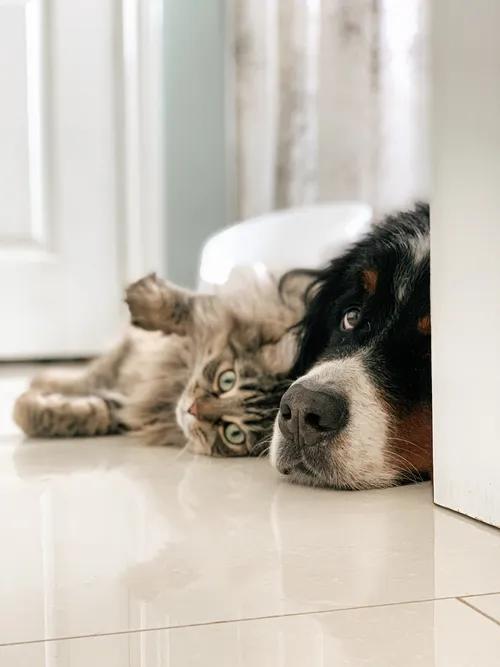Shop by

If you are a pet parent, you have probably witnessed the effects your pet can have on your indoor air quality. After all, most pets leave behind massive amounts of pet dander and allergens. You might have even looked into how to get rid of pet dander in the past to see how to improve the quality of your air for yourself.
However, have you ever thought about indoor air quality the other way around, from your pet’s point of view? Much like humans, pets also need to have high-quality indoor air. Here are the 3 top reasons your furry friend needs high quality indoor as well, and the 4 best ways you get better indoor air for you and your pets.
Just like you, your pet also experiences the effects of both superior and inadequate air quality. In fact, pets tend to suffer more than their human counterparts when it comes to allergens because they are much lower to the ground, where dust, debris, and allergens tend to accumulate. Of course, your furry friend likes to get into and play in all of the nooks and crannies they can, where dust can stay untouched.
If your pet has any pre-existing medical conditions, such as heart disease, diabetes, lower airway disease, or obesity, bad indoor air quality can worsen their ailments. This, in turn, can cause your pet to experience extensive pain and a lower quality of life.
Similarly, if you do not have high-quality indoor air in your home, your pet’s allergies can be triggered. It is believed that approximately 20% of dogs develop allergies throughout the course of their lives. While less common, cats are also prone to developing allergies.
If you have poor indoor air quality and your dog or cat has allergies, their allergies are more prone to being triggered. For example, if you never change your air filters, they will become blocked with dust and debris. The clogged air filter will recirculate dust, debris, and allergens back into your home causing your pet to have various allergy attacks. Indications of allergies could be constant sneezing, coughing, runny eyes, a runny nose, and even a fever.
If you notice that your furry friend is having a hard time breathing, you should take them to the vet right away. If your pet already has allergies and you are worried that they could worsen over time, looking into pet insurance is a precaution that you can take. Pet insurance will help with pet bills so your furry friend can get the care they need. After all, the last thing you want is for them to have to suffer through illnesses and injuries.
On top of worsening pre-existing conditions and precipitating allergies, having subpar air quality can cause your pet to develop long-term health problems. When you have a lot of allergens and molds within your home and you never change your air filter, pollen, dust, pet hair, bacteria, mildew, and various types of molds can build up in your home. If your four-legged friend endures prolonged exposure to these then they can be at risk of developing asthma and bronchitis. If your pet does get asthma or bronchitis, they will lack energy and will have difficulty breathing. Difficult breathing coupled with poor air quality is a recipe for disaster!

Do not wait until your pet develops any health problems and vet bills start piling up before you start thinking about the air quality within your home! Luckily, there are many affordable ways you can make sure you and your pet have high-quality indoor air.
The best way you can ensure that you have clean indoor air is to change your air filters regularly. Ideally, you want to change your air filters every three months or so. However, if you own a pet, you should change them more frequently. Typically, most pet owners should change their air filters every month because pets leave behind a lot of fur and dander. This can substantially lower the quality of your air.
Changing your home’s air filter is a simple task with Filterbuy because we have 600+ sizes to choose from across 3 MERV Ratings. Our Odor Eliminator fitlers are designed with pet owners in mind as they wick away unpleasant pet smells and trap dust, dander, and other pollutants all at once! If you can’t find your filter size, that’s no problem at all -- our custom filter tool allows you to build a filter to the exact dimensions you need. Not to mention that shipping is free for all U.S. orders and our AutoShip subscription program allows you to have new filters delivered to your door before you even need them. Take this quiz to find out if AutoShip is right for you.
In parallel with changing your air filter every month or so, you should also dust and vacuum your home regularly. Dusting and vacuuming are great because they can remove dirt, debris, pet hair, and other particles you can’t see from your home. It’s especially useful for getting these tiny particles out of carpets and preventing mold and mildew from growing. Ideally, you should dust and vacuum your home once a week, however, pet owners might want to do so more often.
Although some pets, especially cats, tend to not like bath time, bathing your pet is another way to improve the quality of the air within your home. You remove loose hair, dirt, dust, odor, and even small insects (like fleas and ticks) when you bathe your furry friend. Not to mention, when you wash your pet, you are improving their coat’s shine and keeping their skin from becoming dry. It also allows you to see any areas of concern underneath their coat that you can bring up to their vet at their next check-up. Furthermore, you only have to wash your furry friend every couple of months, so this can be worked into the schedules of the busiest of people!

The last simple way to drastically increase air quality for your four-legged friend is to make sure that your home does not get too humid. Let’s be honest: almost everyone’s home will get humid at various times throughout the year, particularly during the summer and winter seasons. Conversely, mold and mildew can build up when your home stays humid and moist for extended periods. This drops your air quality and triggers your pet's allergies.
Keep moisture and humidity in check by using dehumidifiers within your home. These are great for eliminating musty odors and helping to prevent the form and spread of mold and mildew. Similarly, make sure you turn on the ventilation fan when you shower, so you can prevent humidity and bacteria build-up.
If you own a pet, you know the great lengths you go to ensure that your pet lives a healthy life. This includes making sure your indoor air quality is exceptional. The steps above are not time-consuming or expensive, and they will tremendously impact your indoor air quality. The last thing you want as a pet owner is to see your furry friend suffer because of poor air!
